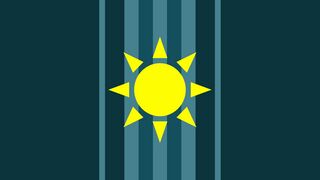New Altnavia (Pacifica): Difference between revisions
mNo edit summary |
|||
| Line 260: | Line 260: | ||
In September 1155, Silivian forces finally surrounded the Alnodeilian capital after successfully blockading. The capital of Alnodeili did not keep a lot of food inside the castle. Silivian forces knew this fact very well and waited outside the castle, hoping for a peaceful Alnodeilian surrender. | In September 1155, Silivian forces finally surrounded the Alnodeilian capital after successfully blockading. The capital of Alnodeili did not keep a lot of food inside the castle. Silivian forces knew this fact very well and waited outside the castle, hoping for a peaceful Alnodeilian surrender. | ||
It took several months for the king of Alnodeili to finally come out of the capital. He had refused to move out of his palace even though he was starving like the others. At last, the Alnodeilian king stepped outside the castle and surrendered to Silivian generals. The Alnodeilian king was imprisoned but not executed, and Alnodeili was | It took several months for the king of Alnodeili to finally come out of the capital. He had refused to move out of his palace even though he was starving like the others. At last, the Alnodeilian king stepped outside the castle and surrendered to Silivian generals. The Alnodeilian king was imprisoned but not executed, and the rest of Alnodeili was annexed by Silivo. | ||
==== Joint attacks on Saredeijia ==== | ==== Joint attacks on Saredeijia ==== | ||
Revision as of 16:41, 6 November 2024
New Altnavia, officially The Democratic Republic of New Altnavia (Pur Ramaedtra Velisia lo Alisi Altineivio) is a unitary state located in northern Bailtem. It is bordered to the east by Andrendia, to the south by Amberholde and Kustannuksa and to the west by Dacian Federation and People’s Republic of San Marsico. The nation’s current leaders are President Christopher Semili Ideipi and Prime Minister James Caliderei Pelidi. The capital and largest city of the nation is Noveopolis.
The Democratic Republic of New Altnavia Pur Ramaedtra Velisia lo Alisi Altineivio | |
|---|---|
|
Flag | |
Motto: Together as one, we build a path to the better ‘neivio’ (peaceful seaside) | |
Anthem: The Light Over The East Horizon | |
| Capital | Noveopolis |
| Official languages | Pacicayan, Silivian and Austral |
| Ethnic groups | Pacicayan 56.5%
Silivian 29.6% Nealti 10.1% Other 3.8% |
| Government | |
• President | Christopher Semili Ideipi |
• Prime Minister | James Caliderei Pelidi |
| Area | |
• Total | 270,328 km2 (104,374 sq mi) |
| Population | |
• Census | 53,408,900 (2023.07) (18) |
• Density | 198/km2 (512.8/sq mi) |
| Currency | Viliceide (VCD) |
| Time zone | UTC +2 |
| Date format | YYYY/MM/DD |
| Driving side | right |
| Calling code | +174 |
| World Forum Code | NA |
| Internet TLD | .nl |
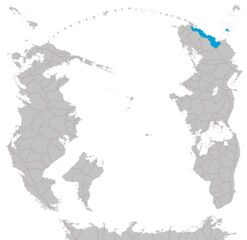 | |
The nation consists of 8 provinces on the mainland of the continent Bailtem and three islands. Most of the nation has a tropical climate. The current republic was founded in September 2022, a month after the former King Laleikiya (1911~2022) passed away with no successors. New Altnavia has a population of 53.4 million, making it the 18th most populous nation in the South Pacific. The official languages of New Altnavia are Pacicayan, Silivian and Austral with Pacicayan being the most well-known language throughout the nation. 95.1% of the people of the nation are from the three main ethnic groups, which are Pacicayan, Silivian and Nealti.
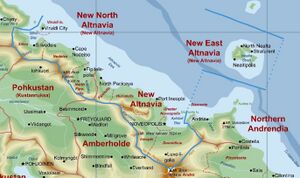
The Pacicayan people are native to the modern-day Donuidicia, Greater Noveopolis, Ineopbi (pronounced ee-nay-yo-bee), Hurudeifa, Fipotalla and North Fipotalla. The Silivians are native to Nodeiso, Silivo and Viruidi Island while the Nealti are native to the region called New East Altnavia.
Etymology
The name ‘New Altnavia’ comes from the kingdom’s name that existed until 2022, which had the same territory as the current republic, called Altineivio Kingdom. In the name ‘Altineivio’, ‘alti’ means ‘beautiful’ in Silivian and ‘neivio’ means ‘peaceful seaside’ in Pacicayan.
History
Prehistory
Exactly when the first humans settled in the modern-day mainland New Altnavia is unknown. It is thought that the event happened 90-150 thousand years ago. The oldest artifacts were discovered along the Pacicaya River, Fipotalla River and Silivo River. Humans gathered to make small towns consisting of about 120 people on average. The small towns traded and fought with one another. These towns are not considered nations as they had a small number of people and didn’t have a proper government.
Early Bronze Age States (1887 BCE ~ 1610 BCE)
The ‘Early Bronze Age States’ refers to the nations that existed between 1887 BCE, when Decidilia was founded, and 1610 BCE, when the Great Deforestation ended.
The First Kingdoms
In the 1900s BCE, towns along the Pacicayan River started to either unite with each other or invade and annex one another. The Kingdom of Decidilia is said to have been founded along the Pacicayan River in 1887 BCE.
At similar times, similar things happened along the river banks of Silivo and Fipotalla. The Kingdom of Luxideis was founded along the Fipotalla River in 1863 BCE and the Kingdom of Servipilo was founded along the Silivo River in 1824 BCE. The three kingdoms continued to extend their borders, annexing small settlements around them.
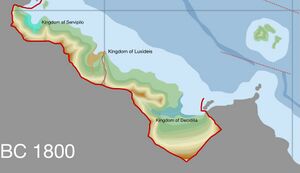
By 1800 BCE, the kingdoms had over 90% of the total population in mainland New Altnavia. They developed cultures, including their own scripts and architecture styles. The land between the nations was mostly taken up by dense rainforests and the forests blocked the kingdoms from extending their territory a lot. Moving through the forests was not easy. However, the kingdoms often traded with and helped one another in many ways and managed to have peaceful relations for several centuries. These few centuries are known as the most peaceful times in all of New Altnavian history.
The Great Deforestation and Territory Extension
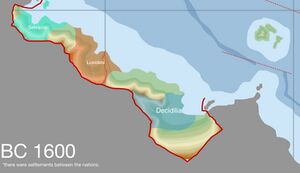
The three ancient kingdoms, Decidilia, Luxideis and Servipilo, grew a lot in population as small tribes between the kingdoms joined them and better farming methods were developed. The most populous, Decidilia is thought to have had over 120 thousand people, which is a lot considering the climate and size of the kingdom. Because of the growing population, more land was needed but the nations were surrounded by the ocean and rainforests. In 1730s BCE, mass deforestation started in modern day Ineopbi by Decidilians. This spread to other regions and other kingdoms and an incredible amount of trees were taken down. This event ended around 1610 BCE, and the kingdoms had grown by an immense amount.
Enneidi Era (1610 BCE ~ 1044 BCE)
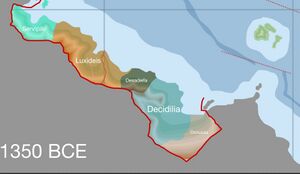
The Enneidi Era began as the Great Deforestation ended. Small deforestation events continued to happen. New nations, known as the Second Generation Bronze Age States were founded.
By 1350 BCE, the nations had control of all the current New Altnavian territory except for Nealta. The five states had peaceful relations for the first two centuries, but started to have wars with one another.
Desadeifa (1542 BCE ~ 1086 BCE)
Desadeifa was founded in modern day Hurudeifa in 1542 BCE by some tribes that lived in the region. At first, it was ruled by a king. However, in 1404 BCE, the king was overthrown and the first republic in the history of New Altnavia was founded. However, there are historians that claim that there was no republic and a new king ruled the nation.
The so-called republic fell in 1383 BCE, and Desadeifa became a kingdom again. Since about then, it had good relations with Decidilia. The two nations helped each other until 1102 BCE, when King Helideira became the king of Decidilia. He did not attack Desadeifa, but refused to continue the good relationship between the nations.
Desadeifa was invaded and conquered by the Kingdom of Luxideis in 1086 BCE.
Donuicia (1563 BCE ~ 1242 BCE)
Donuicia was founded in modern day Sudu Capitalia in 1563 BCE by local tribes and some Decidilians that were tired of the life in Decidilia. The nation grew quickly, absorbing nearby towns. It didn’t have good relations with Decidilia, but Donuicia managed to block Decidilia from annexing the nation in the wars between the two nations, which let Donuicia stay independent for a long time. Donuicia at last fell to Decidilian forces in 1242 BCE.
The Great Enneidi Wars (1067 BCE ~ 1044 BCE)
By 1086 BCE, only the original three kingdoms (Servipilo, Luxideis and Decidilia) existed. Desadeifa had been annexed by Luxideis and Donuicia had been annexed by Decidilia.
Relations between Servipilo and Luxideis were very bad. In the summer of 1067 BCE, Luxideis forces crossed the nation’s northern borders and invaded Servipilo. This event marked the start of the Great Enneidi Wars, which refer to the three wars that happened in the next 23 years.
For the first few months, Servipilo managed to block the massive army of Luxideis from taking its major cities. However, as time passed it grew harder and harder. At last, Servipilo asked Decidilia for help in 1066 BCE.
Decidilian forces invaded the southern part of Luxideis in 1065 BCE. Luxideis, which had most of its forces in the north, lost a lot of land in the south. Servipilo successfully had its first major victory in the war and started to reclaim the land it had lost. With Servipilo and Decidilia attacking at the same time, Luxideis grew weaker and requested a peace treaty in 1062 BCE. The treaty made Luxideis lose a lot of land to its two enemies.
Luxideis soon rebuilt its military. In the autumn of 1055 BCE, Luxideis invaded Decidilia to take control of the territory it had lost. During the first few weeks, Decidilia lost several times, letting Luxideis forces reach a town that was only 30 kilometers away from the Decidilian capital located in modern day Noveopolis. But Luxideis failed to continue, and Decidilian forces pushed Luxideis back to the north. Servipilo also invaded Luxideis in 1053 BCE, and Luxideis grew smaller and weaker. In the spring of 1052 BCE, the capital of Luxideis located in modern day Fipitelepolis was taken over by Decidilian and Servipilian forces and the King of Luxideis surrendered. Decidilia annexed Luxideis territory in the south of the Fipotalla River while Servipilo annexed the northern part. However, some government officials of Servipilo did not accept the border.
In 1047 BCE, the ‘Third Enneidi War’ started as Servipilo forces invaded Decidilia at night. Decidilia, which thought of Servipilo as an ally had not prepared for a war and lost in several battles. Servipilo took control of the entire modern day Fipotalla and started to attack Hurudeifa. But just two months after the start of the war, Decidilia started to win and Servipilo retreated to the north. The war went on for three years and ended in early 1044 BCE as Decidilian forces entered the Servipilian capital. Decidilia had united the mainland New Altnavia for the first time in history, but it only lasted for 7 months. Several rebels started to attack the government in late 1044 BCE, marking the end of the Enneidi Era.
Peleidi Era (1044 BCE ~ 342 BCE)
The Peleidi Era, also known as the Third Bronze Age Era, refers to the years between 1044 BCE and 342 BCE. 1044 BCE is the year when Decidilia united the mainland New Altnavia and soon was divided again and 342 BCE is when Later Luxideis fell and the Iron Age started.
Rebellion and the Division of Decidilia (1044 BCE ~ 1038 BCE)
Only seven months after Decidilia annexed Servipilo and became the first nation to unite the mainland New Altnavia, rebels rose from across the nation. Nations like Later Luxideis, New Servipilo and Ineodicia managed to build a strong nation and stayed independent while a few other nations like West Decidilia was annexed by Decidilia again. Most of the rebellions ended by the 1030s BCE and an era with wars happening very often started.
The Fall of Decidilia and The Rise of Later Luxideis
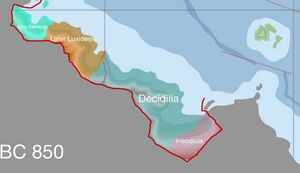
By 850 BCE, Decidilia had lost a lot of land and became weaker because of many wars, rebels and a very unstable government. Ineodicia, a nation built by former Donuician citizens grew larger and destroyed the southern regions of Decidilia. In the north, Later Luxideis had a very strong government and military. Later Luxideis continued to invade Decidilia and managed to annex the modern-day Fipotalla by 790 BCE.
In 748 BCE, rebels demanding lower taxes and a stronger government rose in various parts of Decidilia. In 746 BCE, Ineodicia, Later Luxideis and the Decidilian Rebels made an alliance and started to attack the Decidilian government together. The already weakened Decidilian government could not stop its enemies from extending their territories and the Decidilian Rebels founded the Kingdom of Deceipbi in 734 BCE.
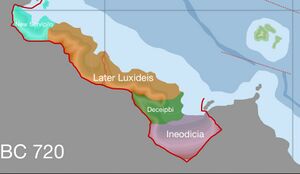
Later Luxideis gained the most land, doubling its territory. It lowered the taxes for its newly annexed regions, which helped Later Luxideis to easily govern the regions.
The three nations’ forces met in the western region of modern day Greater Noveopolis in 729 BCE. The united army had more than five times the size of the Decidilian army and had no trouble in attacking the remaining Decidilian territory. King Heilipio of Decidilia was caught and imprisoned by Ineodician soldiers in the spring of 728 BCE. This led to the surrender of Decidilia, which marked the end of the first kingdom of New Altnavian history.
The leaders of Later Luxideis, Deceipbi and Ineodicia met soon after the Decidilian surrender to discuss the new national borders and decided on the borders shown on the map above. The four nations, including New Servipilo had peaceful relations for several centuries.
Deceipbi-Ineodicia War (413 BCE)
In 415 BCE, King Kajeideiri became king of Ineodicia. Just two years later, the Deceipbi naval forces accidentally attacked and destroyed an Ineodician merchant ship heading to Later Luxideis, thinking that it was a pirate ship. Also, some Ineodician citizens were attacked by a few Deceipbi military members. Outraged by these events, King Kajeideiri declared war on Deceipbi shortly after.
Ineodicia had a stronger military than Deceipbi and soon took over parts of Deceipbi’s territory. But just a month after the start of the war, Later Luxideis sent its army to stop the war. With the help of Later Luxideis, Ineodicia and Deceipbi stopped the war. Thanks to this, peace continued in the region for another few decades.
Start of Iron Age in Later Luxideis
According to Ancient Pacicayan Kingdom Records written in the 200s AD, iron weapons were first produced in a large scale in Later Luxideis in the 390s BCE. It is believed that iron weapons and farming tools were first used by Later Luxideis citizens around that time. The technology was kept a secret until the fall of Later Luxideis.
The Fall of Later Luxideis
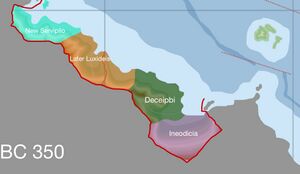
In the 360s BCE, Later Luxideis was getting unstable as the government weakened. The king of Later Luxideis did not care about governing the nation and also disliked the neighboring nations. This made the relations between Later Luxideis and the other nations turn bad.
In 354 BCE, New Servipilian officials visited Deceipbi and Ineodicia to ask for help in putting an end to Later Luxideis. Deceipbi, which didn’t like Later Luxideis agreed immediately, and Ineodicia agreed shortly after. In 352 BCE, the first war between Later Luxideis and the other nations began. Later Luxideis lost, losing a lot of land and resources to its enemies. A peace treaty was signed in 350 BCE.
After the war, Later Luxideis got weaker and rebellion happened in some parts of the nation. The New Servipilo - Deceipbi - Ineodicia army invaded Later Luxideis again in 344 BCE. At last, the capital of Later Luxideis was captured by New Servipilo in 342 BCE. This marked the end of Later Luxideis and the Peleidi Era.
Early Iron Age Kingdoms (342 BCE ~ 693 AD)
The early Iron Age Kingdoms refers to all the nations between 342 BCE and 693 AD.
Early Iron Age Chaos
As Later Luxideis was destroyed, the technology to make iron weapons spread throughout the region, marking the start of the New Altnavian Iron Age. After the big event, two centuries of chaos followed. Dozens of micro-nations were founded based on the new iron technology. Many rebellions happened in large nations. The many nations fought one another for two centuries until the 140s BCE, when the conflicts were settled and there were only four nations existing.
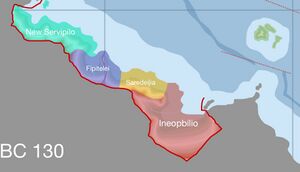
In the 200s BCE, the two nations Deceipbi and Ineodicia merged into Ineopbilio. Ineopbilio rose to become the strongest and most populous nation. In the north, New Servipilo stayed strong as the second most powerful nation. Ineopbilio and New Servipilo played a big role in bringing peace to the region. Nations that existed in modern-day Hurudeifa were united to become Saredeijia and the nations that existed in modern-day Fipotalla were united into Fipitelei.
Even after the chaos were settled in the 140s BCE, small conflicts continued to happen in Saredeijia and Fipitelei. However, they did not grow into a big war thanks to Ineopbilio and New Servipilo putting a stop to the conflicts. No large scale conflicts happened until 278 AD.
Chaos in the 3rd~4th Century (278 ~ 325)
There was a major drought in the 270s, leading to a massive famine in several parts of the region. This wasn’t solved easily, and it led to many people’s hate about their governments.
In 278, the chaos that would continue for almost five decades started as the king of Saredeijia was assassinated by a general. The general immediately took over the kingdom and started invading Ineopbilio, which was not prepared well because of the famine. In 280, Saredeijian forces invaded Fipitelei, which was weakened because of a king that did not care for his people. The king of Saredeijia was killed in his visit to newly conquered Fipitelei lands in 284, but the next king continued the conquering.
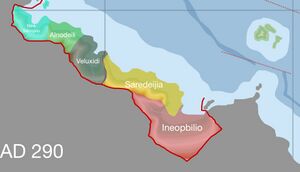
In 285, rebels took over the remaining parts of Fipitelei and founded the kingdom of Veluxidi. Veluxidi had good relations with Saredeijia for a long time. Veluxidi also annexed parts of New Servipilo.
In 287, rebels in the eastern part of New Servipilo founded Alnodeili and fought against the New Servipilo government. By 290, Alnodeili annexed half of New Servipilo. Alnodeili and Veluxidi did not have very good relations at first, but no wars happened until 311.
Alnodeili invaded New Servipilo again in 297 after 7 years of peace. New Servipilo was very weakened and Alnodeili took over almost all of New Servipilo in 302, forcing the remaining New Servipilo government officials to head to the island of Viruidi. Viruidi was annexed in 303, marking the end of New Servipilo.
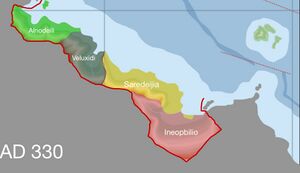
In 311, Veluxidi invaded Alnodeili with Saredeijian support. At first, Alnodeili lost in several battles, but didn’t lose much territory. Peace was achieved in 313, when the king of Veluxidi that led the war died. Veluxidi attacked Alnodeili again in 316 without Saredeijian support but could not advance a lot. The second war ended in 317.
Ineopbilio invaded Saredeijia in 322 to recover its lost territory. Ineopbilio managed to recover parts of its lost territory, but also ended up losing land in other areas to Saredeijia. Peace was achieved in 325 after Saredeijia took control of half of the Ineopbilian coast.
This marked the end of the five decade-long chaos.
Discovery and Development of Nealta (344~)

In 344, a Saredeijian merchant ship carrying about 60 people left what is now Port Ineopbi to never return. The ship was on its way to the northwest when it met a heavy storm. The captain was badly hurt and a passenger that was a former captain had to pilot the ship. However, the sky was too cloudy for several days. This made it hard for the new captain to navigate and ended up going to the northeast. Several days later, the remaining 40 people saw land that no one had ever been to before. The people started living on the southern coast of Nealta Island.
Two weeks later, another storm happened and another ship arrived, this time with 120 people on board. It was a ship sent by the Saredeijian government to search for the missing people. There were now 160 people on the island. There was no hope of returning, so the 160 people stayed on the island. The Kingdom of Nealta was founded soon, with the Saredeijian general who was the captain of the second ship as the king.
By the early 350s, the population grew to 340 people and the kingdom grew larger. No other ships had come. The people lived peacefully under the rule of a generous king.
By the year 379, the population had grown to 870. The kingdom now had people all over the island. Farming started in northern Nealta and western Malidsia, letting the people to get food without having to go into the jungles. The population reached 1000 and continued to grow in the year 387.
No ships moved between Nealta Kingdom and the mainland until the 700s. The island was very peaceful for several centuries without major problems. The 40 people who first reached the islands are the start of the Nealta ethnic group, which has over 5.3 million people today.
Fall of Veluxidi
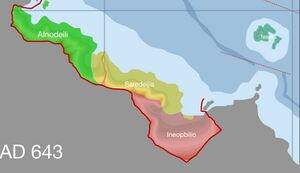
In 624, Queen Unideiliei of Veluxidi, who was a very good leader died at the age of 88. Her cousin, King Olonitelo became the new king. The new king governed the nation poorly, making citizens to become poorer and the nation to become weaker. Citizens rose against the king in 633, just to be attacked and killed by the king’s army. Veluxidi became weaker as time passed. In 641, Alnodeili invaded Veluxidi. In 642, Saredeijia, which became an ally of Alnodeili entered the war. At last, Veluxidi fell to the Alnodeili-Saredeijia army in 643. Alnodeili annexed the western region of Fipotalla River while Saredeijia took control of the eastern region. Thanks to this, Alnodeili grew to a size similar to Saredeijia.
Ineopbilian Invasion of Saredeijia
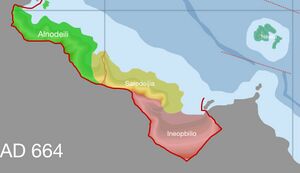
In the 650s, Ineopbilio grew stronger under a strong government. For several centuries, Saredeijia and Ineopbilio had very bad relations. In the late 650s, Ineopbilian officials began to make plans to attack Saredeijia and annex the lands that it lost to Saredeijia several centuries ago.
In 662, Ineopbilio invaded Saredeijia at night. Although Saredeijia and Ineopbilio had extremely bad relations, they did not have major conflicts for several centuries. Because of that, Saredeijia did not have a lot of military on its southern border. Thanks to that, Ineopbilio won its first few battles. However, as soon as Saredeijia moved more of its army to the south, Ineopbilio started to lose. At last, Ineopbilio managed to annex part of Saredeijia and the two nations agreed to a peace treaty in 664.
Vulcanbonian Occupation of Eastern Ineopbilio (667 ~ 686)
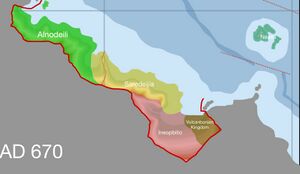
After the Saredeijia-Ineopbilio war (662 ~ 664), Ineopbilio became weaker even though it won. As Ineopbilio attacked Saredeijia, too many resources were used and too much money was spent. A rebellion in 665 made the nation so weak that many citizens had to become robbers or pirates to live. Saredeijia did not invade Ineopbilio.
In 667, Vulcanbonian forces entered Ineopbilio and annexed a part of the nation. Saredeijia prepared its military on the southern border in case of a war between Saredeijia and Vulcanbonia. But thankfully, Vulcanbonian Kingdom did not advance more into Ineopbilian territory. The Vulcanbonian occupation ended in 686.
Fall of Ineopbilio
Even after the Vulcanbonian occupation ended, Ineopbilio could not recover. Laws became useless and even some of the royals had trouble living. The Ineopbilian government could not stop the crisis and collapsed in 691, causing Ineopbilio to become a fallen nation without a government.
Between 691 and 693, many attempts to build a new nation happened several times in Ineopbilio. However, none of them managed to exist for more than a month before collapsing. From 692, Saredeijia started to annex parts of former Ineopbilian territory. In 693, Saredeijia annexed all the remaining parts of Ineopbilio.
This event marks the end of the Early Iron Age Kingdoms and the start of The First Three Kingdoms.
The First Three Kingdoms (693 ~ 1065)
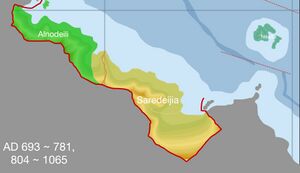
The First Three Kingdoms refers to the kingdoms Alnodeili, Saredeijia and Nealta. For most of the era, there were just these three kingdoms in modern-day New Altnavia. However, there was also another kingdom that lasted for 23 years, from 781 to 804.
The First Three Kingdoms was an era of peace. Saredeijia and Alnodeili were close allies for the entire era. Those two nations and Nealta became allies when the existence of Nealta was told to the Saredeijian government during the 8th century. Except for a civil war and several minor wars in Nealta between 781 and 804, no conflicts happened and the nations grew stronger.
Expeditions of Semeoadi (705 ~ 723)
The Kingdom of Nealta, which was founded by 160 people in 344, developed without any contacts with other nations for several centuries. The kingdom had over 430 thousand people in the late 7th century. The kingdom also had very developed ships, since it consisted of two large islands and had to go out to the sea for fishing.
According to records, King Jaheilipoi of Nealta (672 ~ 741, reign 695 ~ 741) found an old scroll in 699 while walking through his royal library containing historical records. The scroll let King Jaheilipoi know that Nealta was founded by citizens of a kingdom called Saredeijia, somewhere across the sea. King Jaheilipoi, who was very curious about that nation called Saredeijia, sent Semeoadi to find that nation. Semeoadi was a retired ship builder who worked for the royal family. Semeoadi first set off in 705 and sailed northeast with a large fleet. He did find land, but no traces of a kingdom called Saredeijia. He returned in 706.
After he returned, he looked through the historical records in the royal library with permission from the king. He set off again in 711, this time to the south. However, he met a heavy storm and almost got killed when the ship he was on sank because of a large hole on the ship. Semeoadi returned to Nealta three months after he set off.
The third expedition of Semeoadi and his fleet started three years later, in 714 to the west. Records say that they encountered a merchant ship with a green and blue flag. Historians believe that this ship belonged to Alnodeili. However, Semeoadi did not make contact with the merchant ship. He continued to the west and arrived in northern Viruidi. The Nealti sailors and Viruidi townspeople tried to communicate, but it was hard. Although the official languages of Nealta, Saredeijia and Alnodeili were similar, the Viruidi dialect was quite different. On the way back, Semeoadi visited the coasts of Alnodeili but could not hear anything about Saredeijia. Semeoadi returned to Nealta in 717.
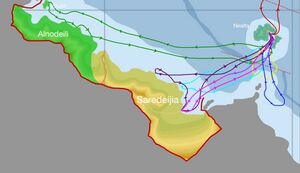
Semeoadi’s fourth expedition began in 718, this time to the southwest. His fleet got very close to Saredeijian territory. However, the Saredeijian navy attacked Semeoadi’s fleet, thinking that they were pirates. Semeoadi was chased away, and returned to Nealta in 719.
Five months later, the fifth expedition began. This time, Semeoadi sailed to the south. However, he became ill and had to return to Nealta just a few months later.
Semeoadi recovered in 721 and set off again for the sixth time. His fleet reached modern-day Hurudeifa, which was controlled by Saredeijia. This time, Semeoadi was not attacked and was able to communicate with the Saredeijian army. The Saredeijian army agreed to take Semeoadi and his fleet to the capital, where the king was. In the capital, Semeoadi met with the king and explained why he was here. Fortunately, the king of Saredeijia knew that Saredeijia lost several ships to a storm almost four centuries ago and did not have plans to invade Nealta when he heard about it. The king of Saredeijia told Semeoadi to bring the Nealti king to his palace, where they could discuss some things.
Semeoadi returned to Nealta in 722 and brought King Jaheilipoi the news. King Jaheilipoi set off later that year with Semeoadi and 1800 of his army in case of danger. The king of Saredeijia welcomed the king of Nealta and his people when they met in Saredeijia’s capital. The king of Saredeijia announced that Saredeijia wishes to have good relations with Nealta. Soon, the Alnodeilian king was invited to Saredeijia. The three kings and Semeoadi had several meetings. At last, it was announced that the three nations will have good relations and will trade. King Jaheilipoi and Semeoadi returned to Nealta in 723, marking the end of the Expeditions of Semeoadi. Semeoadi, who was born in 649, passed away in 724 at the age of 75. He is liked and respected by many Nealti people today.
Unilikelia Kingdom (781 ~ 804)
In 779, King Saedeipoi of Nealta (706 ~ 779, reign 741 ~ 779) died suddenly because of a disease. Since his first child had died several years before him and a heir was not chosen, the king’s death led to many arguments and conflicts. Most of King Saedeipoi’s closest servants wanted the former king’s 15 year old grandson to become the new king. However, Prince Teyipoi, who was the second son of the former king was strongly against that. At last, the former king’s grandson was crowned king. He became King Doerideili (764 ~ 831).
In 780, Prince Teyipoi attempted to assassinate King Doerideili with poison. He failed and was caught. Even though he had committed a crime that could have had him executed, the king sentenced him to be in prison. Prince Teyipoi escaped just four days later and fled to Unilikelia, where many of his supporters lived.

In 781, Prince Teyipoi founded the Kingdom of Unilikelia and became the king after he attacked the local government. King Teyipoi and his army quickly annexed the surrounding regions.
Nealta could not stop the Unilikelian army. Nealti forces kept on losing, and by 785, Nealta had totally lost control of its eastern island. The war was stopped for a short time after peace was achieved in 786. However, Unilikelia invaded Nealta again in 789, with its new stronger navy.
In 790, Unilikelia successfully took over Straturent and continued to advance. Nealta lost North Lerusidin to Unilikelia in 791. Because North Lerusidin was an important city and had many of the nation’s farms, Nealta was weakened by a lot.
Unilikelian forces invaded and annexed parts of southern Nealta in 795. Unilikelian forces slowly approached the Nealti capital of Lerusidin, putting King Doerideili at risk. King Doerideili escaped to Defilideiri in 796 and requested Saredeijian support in the war. Unilikelian forces finally surrounded Lerusidin in 799 and tried to take control of the city. But because Lerusidin was protected by very thick walls and the best Nealti army, Unilikelia failed to annex it after several attacks.
In 800, several ships returned to Nealta from Saredeijia. Over 6000 Saredeijian troops joined the war and quickly took over many parts of former Nealti territory. King Teyipoi was assassinated in 802 by a Nealti spy. This weakened Unilikelia and allowed Nealta to regain almost all of its lost territory. At last, Nealti and Saredeijian forces took over Unilikelia in 804. The remaining supporters of the former king Teyipoi were either executed or sent to prison. This event marked the end of Unilikelia Kingdom.
Chaos and Division in the 11th century
The three kingdoms, which are Alnodeili, Saredeijia and Nealta stayed strong and peaceful for a long time. However, Alnodeili and Saredeijia became weaker from the early 11th century. Nealta continued to stay as a united and strong nation.
In Alnodeili, a successful military coup happened in 1012. The former king was executed by the military and a general was made king (King Yeopelei of Alnodeili, 988 ~ 1031). However, the new king did not govern the nation well and only cared for his and his closest supporters. King Yeopelei was assassinated in 1031 by one of his closest friends, who became the next king of Alnodeili (King Swaloalei of Alnodeili, 991 ~ 1052). During King Swaloalei’s reign, Alnodeili became even more weaker and the lives of normal people became worse. After King Swaloalei died of old age in 1052, the supporters of the king before the 1012 coup gained power again and the grandson of the executed king became the new king of Alnodeili. However, the new king could not fix the big problems in Alnodeili. Due to this, several rebellions happened throughout the nation in the 1060s.
Saredeijia experienced major droughts in 1034, 1036 and 1043. The three droughts led to massive famines. Saredeijia asked Alnodeili and Nealta for help, but could not receive enough. Thousands of people died in Saredeijia and the kingdom became weaker. A new king ascended the throne in 1055. The new king did not govern the kingdom well and left the nation’s people to live in harsh conditions. Because of this, rebellions happened in the late 1050s and 1060s.
The founding of Toreswolia in western Saredeijia (1065) marks the end of The First Three Kingdoms.
The Eight States (1065 ~ 1283)
The 218-year long era was full of chaos. A total of seven nations on the modern-day mainland New Altnavia fought one another to gain more power in the region for over two centuries, until two nations united the seven. The Kingdom of Nealta did not play a major role during this era.
Founding of Toreswolia (1065)
In 1064, a huge rebellion rose in northwestern Saredeijia. Led by Gotoadesi the Great, thousands of people rose against the corrupt government to demand better quality of life. The rebels won against the Saredeijian government army. At last, the Kingdom of Toreswolia was founded, with Gotoadesi as the king.
Under King Gotoadesi’s rule, the region which Toreswolia controlled became peaceful and full of joy. Toreswolia continued to expand, as more Saredeijians rebelled and joined Toreswolia.
Founding of Waldeigalia (1071)
When the Saredeijian government was distracted by Toreswolia in the northwest, another massive rebellion rose in the south. The Saredeijian government could not defend itself from two enemies at the same time, and let the rebels take over the southern region. The rebels, led by Hadainuili the Great founded the Kingdom of Waldeigalia in 1071, with its capital in the modern-day Luxeiligalia.
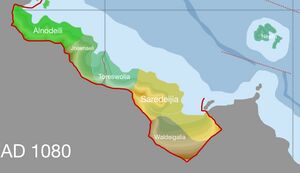
Like Toreswolia, Waldeigalia expanded its territory while the Saredeijian government was very distracted and weak. Waldeigalia also became a peaceful and prosperous nation under King Hadainuili’s rule. Waldeigalia invaded and annexed a lot of farmland in western Saredeijia, weakening Saredeijia even more. Waldeigalia focused on expanding north to cooperate with Toreswolia.
Founding of Joaenaeli (1073)
Rebellions didn’t only happen in Saredeijia, it happened in Alnodeili too. A massive rebellion rose in southeastern Alnodeili in 1072. After over a year of battles, the Kingdom of Joaenaeli was founded on the western bank of Fipotalla River. Joaenaeli expanded to the west, taking over more of Alnodeili’s territory.
Joaenaeli and Toreswolia were not allies. However, the two nations agreed to have peaceful relations in 1074. This led to peace between the two kingdoms that lasted for almost two hundred years until the Toreswolian invasion of Joaenaeli.
Toreswolia-Waldeigalia Alliance
Toreswolia continued to expand to the east while Waldeigalia expanded to the north. Due to the wars, Saredeijia lost a lot of its territory and population. In 1084, Waldeigalian soldiers met Toreswolian soldiers on the Ineopbi Mountain Range. Since the two nations had both started as rebels against Saredeijia, the two kingdoms did not have a battle. Just a few days later, the kings of the two nations met in a small town of Waldeigalia.
The two leaders agreed to not invade each other. They agreed to continue to invade Saredeijia and help the other nation when needed. This helped Toreswolia and Waldeigalia have peaceful relations for several decades.
Founding of Semeleheio (1091)
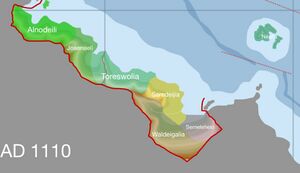
Toreswolia and Waldeigalia continued to invade Saredeijia, weakening it even more. The lives of Saredeijian citizens became poorer as time passed. Since Saredeijia needed more money to pay for the wars it was fighting, the king decided to increase the taxes by a huge amount in 1086. This made the citizens’ lives even more worse.
The high taxes didn’t only affect normal citizens, it also affected high-ranking government officials and their families. Tired of the high taxes, Saredeijian general Opaleheide and Oghadeiri attempted a coup against the Saredeijian government in 1088. The two generals were trusted by the Saredeijian king and had been on a mission to attack eastern Waldeigalia. However, the coup failed after one of Opaleheide’s servants betrayed the general and gave the king’s army important information. Opaleheide was captured and executed soon after. Oghadeiri escaped to the east and secretly grew his army.
In 1091, Oghadeiri attacked the king’s army once more and founded Semeleheio in eastern Saredeijia. Because Saredeijia was too busy focusing on Toreswolia and Waldeigalia, Oghadeiri won many times and Semeleheio grew larger. By 1110, Semeleheio had annexed territory extremely close to the Saredeijian capital. This caused Saredeijia to move its capital to the north.
Saredeijia-Semeleheio Joint Attacks on Waldeigalia
Even with a bit of support from Nealta, Saredeijia was having a hard time fighting three enemies at the same time. Saredeijia decided that it will recognize Semeleheio as a proper independent nation and offered peace to Semeleheio in 1117. Semeleheio, which was being threatened by Waldeigalia agreed to have peaceful relations with Saredeijia.
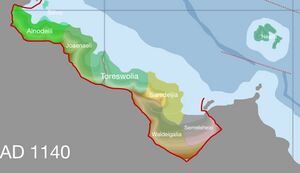
Saredeijia and Semeleheio, which were both being threatened or attacked by Waldeigalia decided to attack at the same time. In 1121, the two kingdoms invaded Waldeigalia during the harvesting season. At the same time, Saredeijia launched attacks on Toreswolia with support from Nealta. The war between the five nations lasted several years. The war finally ended in 1128. Saredeijia and Semeleheio won, and gained more territory.
Founding of Silivo (1134)
As Joaenaeli continued to annex more of eastern Alnodeilian territory, Alnodeili grew weaker and its people’s lives became worse. The second son of the Alnodeilian king opposed his father’s ideas and often argued with him. Mad at his son, the king sent the prince to live in the island which is now Viruidi in 1133. The next year, the king died. His first son had died a few days ago, which meant the next king should be the prince who was sent to Viruidi. However, it was revealed that the king had wanted to make his third son the new king. The dead king’s supporters made the king’s third son as the new king. Outraged that he, the person who should have become the king according to the nation’s laws, the prince in Viruidi attacked Alnodeili with his supporters and founded Silivo. From then, the prince was known as King Nedelesli.
Under the rule of King Nedelesli, Silivo grew stronger while Alnodeili was getting weaker as war with Joaenaeli continued. Alnodeilian people’s lives were very miserable, even for the rich ones. Silivian forces invaded parts of Alnodeilian coast in 1138 and continued to grow.
Fall of Alnodeili (1156)
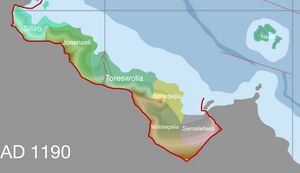
Led by King Nedelesli himself, Silivo launched a successful attack on Northwestern Alnodeili and annexed the region. The Silivian navy got information related to strong Alnodeili ships. This helped Silivo to grow its navy to be similar to the Alnodeilian navy.
In 1149, the Joaenaelian king offered Silivo to invade Alnodeili together. Silivo soon agreed, and war began in 1150. Many miserable Alnodeilians, including government officials did not fight against the invaders. They fought with the invaders, hoping that it will make their lives better.
Joaenaeli experienced a coup attempt in 1152. The scale of the attempt was huge, and Joaenaeli had to withdraw its army fighting against Alnodeili to defend the royals. It failed and those who were related to it were executed. Joaenaeli started its invasion on Alnodeili again in 1154, helping Silivian forces. Joaenaeli withdrew its military again in early 1155 as it experienced another coup attempt. Joaenaeli did not rejoin the war after the event.
In September 1155, Silivian forces finally surrounded the Alnodeilian capital after successfully blockading. The capital of Alnodeili did not keep a lot of food inside the castle. Silivian forces knew this fact very well and waited outside the castle, hoping for a peaceful Alnodeilian surrender.
It took several months for the king of Alnodeili to finally come out of the capital. He had refused to move out of his palace even though he was starving like the others. At last, the Alnodeilian king stepped outside the castle and surrendered to Silivian generals. The Alnodeilian king was imprisoned but not executed, and the rest of Alnodeili was annexed by Silivo.
Joint attacks on Saredeijia
When the news of Alnodeilian surrender spread throughout the region, Saredeijian royals started to worry about their fate. Attacks on Saredeijia was being done simultaneously by three nations, which are Toreswolia, Semeleheio and Waldeigalia. There were also conflicts between the government and the citizens in Saredeijia. The Saredeijian government could not handle the situation properly, letting Saredeijia lose a lot of its territory. Saredeijia was allied with Nealta, but Saredeijia could not receive a lot of help from Nealta.
In 1173, Toreswolia, Waldeigalia and Semeleheio agreed to stop conflicts between the three nations for a while and invade Saredeijia together. The three nations prepared their military for their attack. The war, known as Grodornei War began in 1174 as Toreswolia started naval attacks on northern Saredeijia.
The Grodornei War, which was fought by four countries, was one of the largest conflicts during The Eight States. It finally ended in 1178. The Second Grodornei war happened in 1181 and continued until 1183. The two wars devastated Saredeijia, making it seem impossible for Saredeijia to recover.
